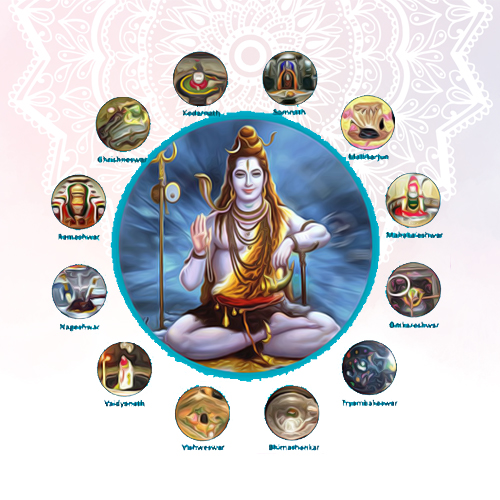
Dwadash jyotirlinga path
The Dwadash Jyotirlinga Path is a revered practice involving the recitation of the Dwadash Jyotirlinga Stotra, which praises the twelve sacred Jyotirlingas of Lord Shiva. This ritual is performed to invoke the blessings of Lord Shiva for spiritual growth, protection, and liberation.
The Twelve Jyotirlingas
- Somnath (Gujarat): The first among the twelve Jyotirlingas, located in Prabhas Patan near Veraval.
- Mallikarjuna (Andhra Pradesh): Located on the Srisailam mountain, also known as Srisaileshwara.
- Mahakaleshwar (Madhya Pradesh): Located in Ujjain, known for its unique Bhasma Aarti.
- Omkareshwar (Madhya Pradesh): Located on an island in the Narmada River.
- Kedarnath (Uttarakhand): Situated in the Himalayas, accessible during specific months due to weather conditions.
- Bhimashankar (Maharashtra): Located in the Sahyadri region, surrounded by dense forests.
- Kashi Vishwanath (Uttar Pradesh): Situated in Varanasi, one of the holiest cities in India.
- Trimbakeshwar (Maharashtra): Located near Nashik, close to the source of the Godavari River.
- Vaidyanath (Jharkhand): Also known as Baidyanath, located in Deoghar.
- Nageshwar (Gujarat): Located near Dwarka, also known as Dwarkadhish.
- Ramanathaswamy (Tamil Nadu): Located on Rameswaram island, known for its long corridors and massive sculpted pillars.
- Grishneshwar (Maharashtra): Located near the Ellora Caves, the smallest of the twelve Jyotirlingas.
Procedure and Steps
Preparation
- Purify Yourself and the Space: Take a bath to cleanse yourself. Clean the space where you will perform the recitation.
- Set Up an Altar: Arrange an image or idol of Lord Shiva along with flowers, incense, a lamp (diya), and other offerings like fruits, milk, honey, and water.
Steps
-
Invoke Lord Ganesha: Begin by praying to Lord Ganesha to remove obstacles and ensure the smooth conduct of the ritual.
-
Lighting the Lamp: Light a lamp (diya) and incense to purify the surroundings.
-
Offerings: Offer flowers, fruits, and other items to the image or idol of Lord Shiva.
-
Recitation of Dwadash Jyotirlinga Stotra
-
Aarti: Conclude the recitation with aarti (a devotional song and offering of light) to Lord Shiva.
-
Prayers: Offer a concluding prayer, seeking blessings for yourself and your loved ones.
-
Distribution of Prasad: Distribute the offerings (prasad) among the participants or consume it yourself as a blessing.
Benefits of Dwadash Jyotirlinga Path
- Spiritual Growth: Enhances spiritual awareness and fosters a deeper connection with Lord Shiva.
- Protection: Invokes the protective energy of Lord Shiva, safeguarding against negative forces and evil energies.
- Purification: Purifies the mind, body, and soul, removing sins and past karma.
- Health and Well-being: Promotes physical and mental well-being through the divine grace of Lord Shiva.
- Blessings and Prosperity: Brings divine blessings for success, prosperity, and overall happiness in life.
- Mental Clarity: Improves concentration, focus, and mental clarity.
- Liberation (Moksha): Aids in attaining liberation and freedom from the cycle of birth and death.
The Dwadash Jyotirlinga Path is a significant practice for devotees of Lord Shiva. It is a means to connect deeply with the divine and seek Lord Shiva's grace for overcoming challenges, achieving spiritual milestones, and experiencing the ultimate truth. Performing this path with devotion and sincerity is believed to bring immense spiritual benefits and blessings from Lord Shiva.
 Add Temple
Add Temple